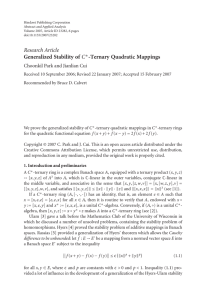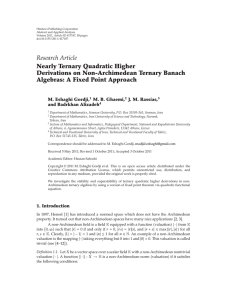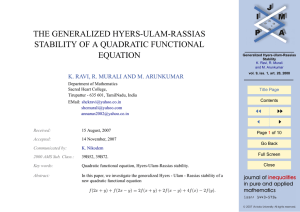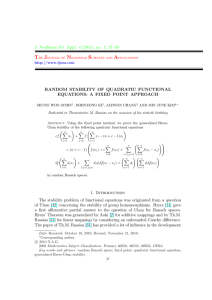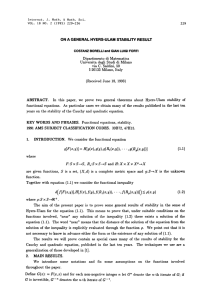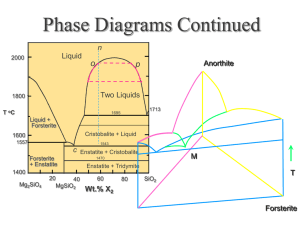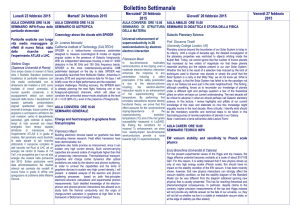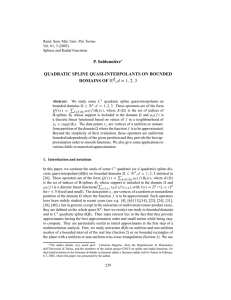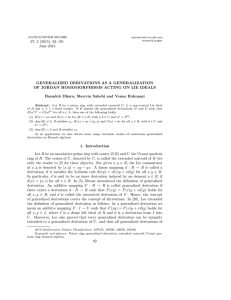T J N S
advertisement
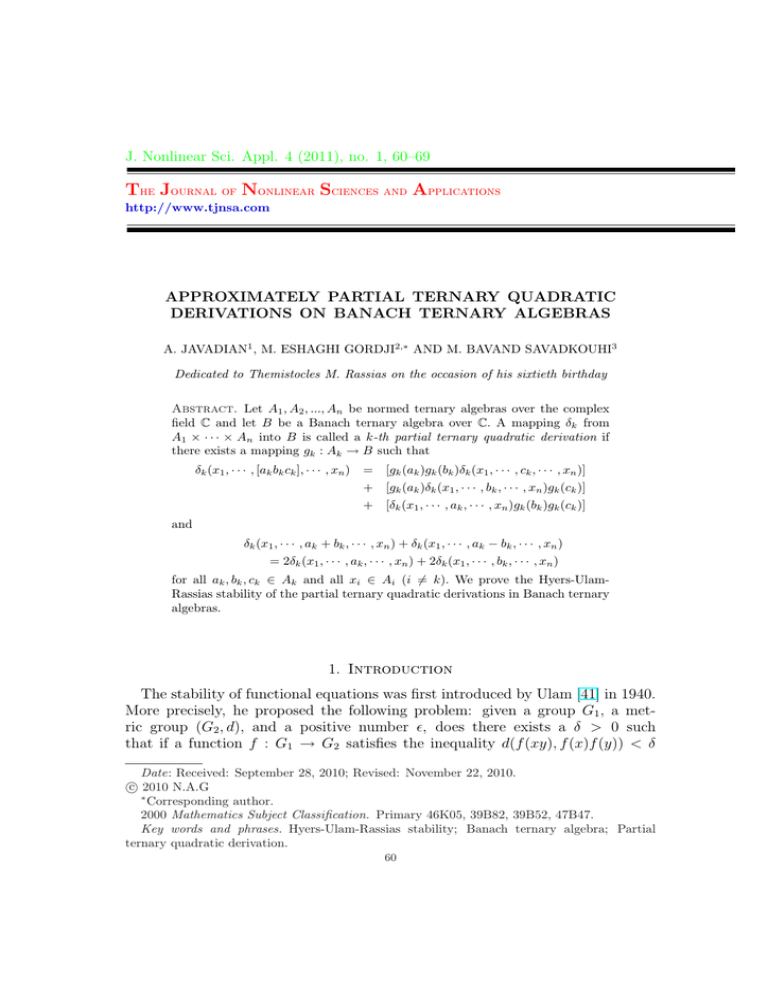
J. Nonlinear Sci. Appl. 4 (2011), no. 1, 60–69
The Journal of Nonlinear Sciences and Applications
http://www.tjnsa.com
APPROXIMATELY PARTIAL TERNARY QUADRATIC
DERIVATIONS ON BANACH TERNARY ALGEBRAS
A. JAVADIAN1 , M. ESHAGHI GORDJI2,∗ AND M. BAVAND SAVADKOUHI3
Dedicated to Themistocles M. Rassias on the occasion of his sixtieth birthday
Abstract. Let A1 , A2 , ..., An be normed ternary algebras over the complex
field C and let B be a Banach ternary algebra over C. A mapping δk from
A1 × · · · × An into B is called a k-th partial ternary quadratic derivation if
there exists a mapping gk : Ak → B such that
δk (x1 , · · · , [ak bk ck ], · · · , xn )
= [gk (ak )gk (bk )δk (x1 , · · · , ck , · · · , xn )]
+ [gk (ak )δk (x1 , · · · , bk , · · · , xn )gk (ck )]
+ [δk (x1 , · · · , ak , · · · , xn )gk (bk )gk (ck )]
and
δk (x1 , · · · , ak + bk , · · · , xn ) + δk (x1 , · · · , ak − bk , · · · , xn )
= 2δk (x1 , · · · , ak , · · · , xn ) + 2δk (x1 , · · · , bk , · · · , xn )
for all ak , bk , ck ∈ Ak and all xi ∈ Ai (i 6= k). We prove the Hyers-UlamRassias stability of the partial ternary quadratic derivations in Banach ternary
algebras.
1. Introduction
The stability of functional equations was first introduced by Ulam [41] in 1940.
More precisely, he proposed the following problem: given a group G1 , a metric group (G2 , d), and a positive number ², does there exists a δ > 0 such
that if a function f : G1 → G2 satisfies the inequality d(f (xy), f (x)f (y)) < δ
Date: Received: September 28, 2010; Revised: November 22, 2010.
c 2010 N.A.G
°
∗
Corresponding author.
2000 Mathematics Subject Classification. Primary 46K05, 39B82, 39B52, 47B47.
Key words and phrases. Hyers-Ulam-Rassias stability; Banach ternary algebra; Partial
ternary quadratic derivation.
60
PARTIAL TERNARY QUADRATIC DERIVATIONS
61
for all x, y ∈ G1 , then there exists a homomorphism T : G1 → G2 such that
d(f (x), T (x)) < ² for all x ∈ G1 ? As mentioned above, when this problem has
a solution, we say that the homomorphisms from G1 to G2 are stable. In 1941,
Hyers [31] gave a partial solution of Ulam’s problem for the case of approximate
additive mappings under the assumption that G1 and G2 are Banach spaces. In
1978, Rassias [39] generalized the theorem of Hyers by considering the stability
problem with unbounded Cauchy differences. This phenomenon of stability that
was introduced by Rassias [39] is called the Hyers-Ulam-Rassias stability. The
following is according to Rassias’ theorem.
Theorem 1.1. Let f : E → E 0 be a mapping from a norm vector space E into a
Banach space E 0 subject to the inequality
kf (x + y) − f (x) − f (y)k ≤ ²(kxkp + kykp )
for all x, y ∈ E, where ² and p are constants with ² > 0 and p < 1. Then there
exists a unique additive mapping T : E → E 0 such that for all x ∈ E,
2²
kf (x) − T (x)k ≤
kxkp .
2 − 2p
This new concept is known as Hyers-Ulam-Rassias stability of functional equations (see [27],[28],[30],[32],[35],[36] and [38]). The functional equation
f (x + y) + f (x − y) = 2f (x) + 2f (y)
(1.1)
is related to symmetric bi-additive function. It is natural that this equation
is called a quadratic functional equation. In particular, every solution of the
quadratic equation (1.1) is said to be a quadratic function. It is well known that
a function f between real vector spaces is quadratic if and only if there exists a
unique symmetric bi-additive function B such that f (x) = B(x, x) for all x (see
[34]). The bi-additive function B is given by
1
B(x, y) = (f (x + y) − f (x − y))
4
Hyers-Ulam-Rassias stability problem for the quadratic functional equation (1.1)
was proved by Skof for functions f : A −→ B, where A is normed space and
B Banach space (see [4],[6],[29] and [40]). For more detailed definitions of such
terminologies, we can refer to [1],[7]–[14],[16],[19]–[22] and [24].
A ternary (associative) algebra (A, [ ]) is a linear space A over a scalar field
F = R or C equipped with a linear mapping, the so-called ternary product,
[ ] : A×A×A → A such that [[abc]de] = [a[bcd]e] = [ab[cde]] for all a, b, c, d, e ∈ A.
This notion is a natural generalization of the binary case. Indeed if (A, ¯) is a
usual (binary) algebra then [abc] := (a ¯ b) ¯ c induced a ternary product making A in to a ternary algebra which will be called trivial. By a Banach ternary
algebra we mean a ternary algebra equipped with a complete norm k.k such that
k[abc]k ≤ kakkbkkck for all a, b, c ∈ A. It seems that approximate derivations were
first investigated by Jun and Park [33]. Recently, the stability of derivations has
been investigated by some authors; see [2, 5, 23, 26] and references therein. For
more detailed definitions of such terminologies, we can refer to [3],[15],[17],[18],[25]
62
A. JAVADIAN, M. ESHAGHI GORDJI, M. BAVAND SAVADKOUHI
and [37].
2. Main results
Let A1 , A2 , ..., An be normed ternary algebras over the complex field C and let
B be a Banach ternary algebra over C. A mapping δk from A1 × · · · × An into
B is called a k-th partial ternary quadratic derivation if there exists a mapping
gk : Ak → B such that
δk (x1 , · · · , [ak bk ck ], · · · , xn ) = [gk (ak )gk (bk )δk (x1 , · · · , ck , · · · , xn )]
+ [gk (ak )δk (x1 , · · · , bk , · · · , xn )gk (ck )]
+ [δk (x1 , · · · , ak , · · · , xn )gk (bk )gk (ck )]
and
δk (x1 , · · · , ak + bk , · · · , xn ) + δk (x1 , · · · , ak − bk , · · · , xn )
= 2δk (x1 , · · · , ak , · · · , xn ) + 2δk (x1 , · · · , bk , · · · , xn )
for all ak , bk , ck ∈ Ak and all xi ∈ Ai (i 6= k). We denote that 0k , 0B are zero
elements of Ak , B, respectively.
Theorem 2.1. Let p ≥ 0 be given with p < 2 and let θ be nonnegative real
numbers. Let Fk : A1 × · · · × An → B be a mapping with Fk (x1 , · · · , 0k , · · · , xn ) =
0B . Suppose that there exists a quadratic mapping gk : Ak → B such that
kFk (x1 , · · · , ak + bk , · · · , xn ) + Fk (x1 , · · · , ak − bk , · · · , xn )
−2Fk (x1 , · · · , ak , · · · , xn ) − 2Fk (x1 , · · · , bk , · · · , xn )k
≤ θ(kak kp + kbk kp )
(2.1)
kFk (x1 , · · · , [ak bk ck ], · · · , xn ) − [gk (ak )gk (bk )Fk (x1 , · · · , ck , · · · , xn )]
(2.2)
−[gk (ak )Fk (x1 , · · · , bk , · · · , xn )gk (ck )] − [Fk (x1 , · · · , ak , · · · , xn )gk (bk )gk (ck )]k
≤ θ(kak kp + kbk kp + kck kp )
for all ak , bk , ck ∈ Ak , xi ∈ Ai (i 6= k). Then there exists a unique k-th partial
ternary quadratic derivation δk : A1 × · · · × An → B such that
kFk (x1 , · · · , xn ) − δk (x1 , · · · , xn )k ≤
2θ
kxk kp
4 − 2p
(2.3)
holds for all xi ∈ Ai (i = 1, 2, · · · , n).
Proof. In (2.1), putting ak = bk = xk , we have
kFk (x1 , · · · , 2xk , · · · , xn ) − 4Fk (x1 , · · · , xk , · · · , xn )k ≤ 2θkxk kp ,
(2.4)
that is,
θ
1
kFk (x1 , · · · , xk , · · · , xn ) − Fk (x1 , · · · , 2xk , · · · , xn )k ≤ kxk kp
4
2
(2.5)
PARTIAL TERNARY QUADRATIC DERIVATIONS
63
for all xi ∈ Ai (i = 1, 2, · · · , n). One can use induction on m to show that
kFk (x1 , · · · , xk , · · · , xn ) −
≤
1
22m
Fk (x1 , · · · , 2m xk , · · · , xn )k
m−1
θ X i(p−2)
2
kxk kp
2 i=0
(2.6)
for all xi ∈ Ai (i = 1, 2, · · · , n) and all non-negative integers m. Hence
k
1
1
Fk (x1 , · · · , 2j xk , · · · , xn ) − 2(m+j) Fk (x1 , · · · , 2(m+j) xk , · · · , xn )k
2j
2
2
m+j−1
θ X i(p−2)
≤
2
kxk kp
(2.7)
2 i=j
for all non-negative integers m and j with m ≥ j and all xi ∈ Ai (i = 1, 2, · · · , n).
1
It follows from p < 2 that the sequence { 22m
Fk (x1 , · · · , 2m xk , · · · , xn )} is Cauchy.
Due to the completeness of B, this sequence is convergent. So one can define the
mapping δk : A1 × · · · × An → B given by
δk (x1 , · · · , xn ) = lim
1
m→∞ 22m
Fk (x1 , · · · , 2m xk , · · · , xn )
(2.8)
for all xi ∈ Ai (i = 1, · · · , n). In (2.1), replacing ak , bk with 2m ak , 2m bk , respectively, we obtain that
k
1
22m
Fk (x1 , · · · , 2m (ak + bk ), · · · , xn ) +
−
2
22m
1
22m
Fk (x1 , · · · , 2m (ak − bk ), · · · , xn )
Fk (x1 , · · · , 2m ak , · · · , xn ) −
2
22m
Fk (x1 , · · · , 2m bk , · · · , xn )k
≤ θ · 2m(p−2) (kak kp + kbk kp )
which tends to zero as m → ∞. Thus we obtain
δk (x1 , · · · , ak + bk , · · · , xn ) + δk (x1 , · · · , ak − bk , · · · , xn )
= 2δk (x1 , · · · , ak , · · · , xn ) + 2δk (x1 , · · · , bk , · · · , xn )
(2.9)
for all ak , bk ∈ Ak and all xi ∈ Ai (i 6= k). Hence δk is quadratic with respect to
the k-th variable. It follows from (2.7) that
kFk (x1 , · · · , xk , · · · , xn ) − δk (x1 , · · · , xk , · · · , xn )k ≤
2θ
kxk kp
4 − 2p
for all xi ∈ Ai (i = 1, 2, · · · , n).
Replacing ak , bk , ck with 2m ak , 2m bk , 2m ck , respectively, in (2.2), we obtain
kFk (x1 , · · · , 23m [ak bk ck ], · · · , xn ) − [22m gk (ak )22m gk (bk )Fk (x1 , · · · , 2m ck , · · · , xn )]
−[22m gk (ak )Fk (x1 , · · · , 2m bk , · · · , xn )22m gk (ck )]
−[Fk (x1 , · · · , 2m ak , · · · , xn )22m gk (bk )22m gk (ck )]k
≤ 2mp .θ(kak kp + kbk kp + kck kp ).
64
A. JAVADIAN, M. ESHAGHI GORDJI, M. BAVAND SAVADKOUHI
Then we have
k
1
26m
Fk (x1 , · · · , 23m [ak bk ck ], · · · , xn )
−
−
−
1
26m
1
26m
1
26m
[22m gk (ak )22m gk (bk )Fk (x1 , · · · , 2m ck , · · · , xn )]
[22m gk (ak )Fk (x1 , · · · , 2m bk , · · · , xn )22m gk (ck )]
[Fk (x1 , · · · , 2m ak , · · · , xn )22m gk (bk )22m gk (ck )]k
≤ 2m(p−6) .θ(kak kp + kbk kp + kck kp ).
for all ak , bk , ck ∈ Ak . Passing the limit m → ∞ in above inequality, we obtain
δk (x1 , · · · , [ak bk ck ], · · · , xn ) = [gk (ak )gk (bk )δk (x1 , · · · , ck , · · · , xn )]
+ [gk (ak )δk (x1 , · · · , bk , · · · , xn )gk (ck )]
+ [δk (x1 , · · · , ak , · · · , xn )gk (bk )gk (ck )]
for all ak , bk , ck ∈ Ak and all xi ∈ Ai (i 6= k).
0
Finally, to prove the uniqueness of δk , let δk : A1 × · · · × An → B be another k-th
partial ternary quadratic derivation satisfying (2.3). Then we have
0
kδk (x1 , · · · , xn ) − δk (x1 , · · · , xn )k
1
0
= 2m kδk (x1 , · · · , 2m xk , · · · , xn ) − δk (x1 , · · · , 2m xk , · · · , xn )k
2
1
≤ 2m (kδk (x1 , · · · , 2m xk , · · · , xn ) − Fk (x1 , · · · , 2m xk , · · · , xn )k
2
0
+ kFk (x1 , · · · , 2m xk , · · · , xn ) − δk (x1 , · · · , 2m xk , · · · , xn )k)
∞
X
≤θ
2i(p−2) kxk kp .
i=m
which tends to zero as m → ∞ for all xi ∈ Ai (i = 1, 2, · · · , n). So we can conclude
0
that δk (x1 , · · · , xn ) = δk (x1 , · · · , xn ). This proves the uniqueness of δ.
¤
Theorem 2.2. Let p > 2 be and let θ be nonnegative real numbers. Let Fk :
A1 × · · · × An → B be a mapping with Fk (x1 , · · · , 0k , · · · , xn ) = 0B . Suppose that
there exists a quadratic mapping gk : Ak → B such that satisfying (2.1) and (2.2)
for all ak , bk , ck ∈ Ak , xi ∈ Ai (i 6= k). Then there exists a unique k-th partial
ternary quadratic derivation δk : A1 × · · · × An → B such that
kFk (x1 , · · · , xn ) − δk (x1 , · · · , xn )k ≤
2θ
kxk kp
−4
(2.10)
2p
holds for all xi ∈ Ai (i = 1, 2, · · · , n).
Proof. In (2.1), putting ak = bk =
xk
,
2
we have
kFk (x1 , · · · , xk , · · · , xn ) − 4Fk (x1 , · · · , x2k , · · · , xn )k ≤
2θ
kxk kp ,
2p
(2.11)
PARTIAL TERNARY QUADRATIC DERIVATIONS
65
for all xi ∈ Ai (i = 1, 2, · · · , n). One can use induction on m to show that
xk
kFk (x1 , · · · , xk , · · · , xn ) − 22m Fk (x1 , · · · , m , · · · , xn )k
2
m−1
X
2θ
≤ p
2i(2−p) kxk kp
(2.12)
2 i=0
for all xi ∈ Ai (i = 1, 2, · · · , n) and all non-negative integers m. Hence
xk
xk
k22j Fk (x1 , · · · , j , · · · , xn ) − 22(m+j) Fk (x1 , · · · , (m+j) , · · · , xn )k
2
2
m+j−1
2θ X i(2−p)
≤ p
2
kxk kp
(2.13)
2 i=j
for all non-negative integers m and j with m ≥ j and all xi ∈ Ai (i = 1, 2, · · · , n).
It follows from p > 2 that the sequence {22m Fk (x1 , · · · , 2xmk , · · · , xn )} is Cauchy.
Due to the completeness of B, this sequence is convergent. So one can define the
mapping δk : A1 × · · · × An → B given by
xk
δk (x1 , · · · , xn ) = lim 22m Fk (x1 , · · · , m , · · · , xn )
(2.14)
m→∞
2
for all xi ∈ Ai (i = 1, · · · , n). In (2.1), replacing ak , bk with 2amk , 2bmk , respectively,
we obtain that
ak + bk
ak − bk
k22m Fk (x1 , · · · ,
, · · · , xn ) + 22m Fk (x1 , · · · ,
, · · · , xn )
m
2
2m
bk
ak
−2 · 22m Fk (x1 , · · · , m , · · · , xn ) − 2 · 22m Fk (x1 , · · · , m , · · · , xn )k
2
2
m(2−p)
≤θ·2
(kak kp + kbk kp )
which tends to zero as m → ∞. Thus we obtain
δk (x1 , · · · , ak + bk , · · · , xn ) + δk (x1 , · · · , ak − bk , · · · , xn )
= 2δk (x1 , · · · , ak , · · · , xn ) + 2δk (x1 , · · · , bk , · · · , xn )
(2.15)
for all ak , bk ∈ Ak and all xi ∈ Ai (i 6= k). Hence δk is quadratic with respect to
the k-th variable. It follows from (2.12) that
2θ
kFk (x1 , · · · , xk , · · · , xn ) − δk (x1 , · · · , xk , · · · , xn )k ≤ p
kxk kp
2 −4
for all xi ∈ Ai (i = 1, 2, · · · , n).
Replacing ak , bk , ck with 2amk , 2bmk , 2cmk , respectively, in (2.2), we obtain
kFk (x1 , · · · ,
gk (ak ) gk (bk )
ck
[ak bk ck ]
, · · · , xn ) − [ 2m
Fk (x1 , · · · , m , · · · , xn )]
3m
2m
2
2
2
2
gk (ak )
bk
gk (ck )
−[ 2m Fk (x1 , · · · , m , · · · , xn ) 2m ]
2
2
2
gk (bk ) gk (ck )
ak
]k
−[Fk (x1 , · · · , m , · · · , xn ) 2m
2
2
22m
θ
≤ mp (kak kp + kbk kp + kck kp ).
2
66
A. JAVADIAN, M. ESHAGHI GORDJI, M. BAVAND SAVADKOUHI
Then we have
k26m Fk (x1 , · · · ,
[ak bk ck ]
gk (ak ) gk (bk )
ck
, · · · , xn ) − 26m [ 2m
Fk (x1 , · · · , m , · · · , xn )]
3m
2m
2
2
2
2
g
(a
)
b
gk (ck )
k k
k
−26m [ 2m Fk (x1 , · · · , m , · · · , xn ) 2m ]
2
2
2
gk (bk ) gk (ck )
ak
−26m [Fk (x1 , · · · , m , · · · , xn ) 2m
]k
2
2
22m
≤ 2m(6−p) .θ(kak kp + kbk kp + kck kp ).
for all ak , bk , ck ∈ Ak . Passing the limit m → ∞ in above inequality, we obtain
δk (x1 , · · · , [ak bk ck ], · · · , xn ) = [gk (ak )gk (bk )δk (x1 , · · · , ck , · · · , xn )]
+ [gk (ak )δk (x1 , · · · , bk , · · · , xn )gk (ck )]
+ [δk (x1 , · · · , ak , · · · , xn )gk (bk )gk (ck )]
for all ak , bk , ck ∈ Ak and all xi ∈ Ai (i 6= k).
0
Finally, to prove the uniqueness of δk , let δk : A1 × · · · × An → B be another k-th
partial ternary quadratic derivation satisfying (2.10). Then we have
0
kδk (x1 , · · · , xn ) − δk (x1 , · · · , xn )k
xk
xk
0
= 22m kδk (x1 , · · · , m , · · · , xn ) − δk (x1 , · · · , m , · · · , xn )k
2
2
xk
xk
2m
≤ 2 (kδk (x1 , · · · , m , · · · , xn ) − Fk (x1 , · · · , m , · · · , xn )k
2
2
xk
xk
0
+ kFk (x1 , · · · , m , · · · , xn ) − δk (x1 , · · · , m , · · · , xn )k)
2
2
∞
X
≤θ
2i(2−p) kxk kp .
i=m
which tends to zero as m → ∞ for all xi ∈ Ai (i = 1, 2, · · · , n). So we can conclude
0
that δk (x1 , · · · , xn ) = δk (x1 , · · · , xn ). This proves the uniqueness of δ.
¤
By Theorems 2.1 and 2.2 we solve the following Hyers-Ulam-Rassias stability
problem.
Theorem 2.3. Let ² be nonnegative real numbers and let Fk : A1 ×· · ·×An → B be
a mapping with Fk (x1 , · · · , 0k , · · · , xn ) = 0B . Assume that there exist a quadratic
mapping gk : Ak → B such that
kFk (x1 , · · · , ak + bk , · · · , xn ) + Fk (x1 , · · · , ak − bk , · · · , xn )
−2Fk (x1 , · · · , ak , · · · , xn ) − 2Fk (x1 , · · · , bk , · · · , xn )k ≤ ²
(2.16)
kFk (x1 , · · · , [ak bk ck ], · · · , xn ) − [gk (ak )gk (bk )Fk (x1 , · · · , ck , · · · , xn )]
−[gk (ak )Fk (x1 , · · · , bk , · · · , xn )gk (ck )]
(2.17)
−[Fk (x1 , · · · , ak , · · · , xn )gk (bk )gk (ck )]k ≤ ²
PARTIAL TERNARY QUADRATIC DERIVATIONS
67
for all ak , bk , ck ∈ Ak , xi ∈ Ai (i 6= k). Then there exists a unique k-th partial
ternary quadratic derivation δk : A1 × · · · × An → B such that
kFk (x1 , · · · , xn ) − δk (x1 , · · · , xn )k ≤
²
3
(2.18)
holds for all xi ∈ Ai (i = 1, 2, · · · , n).
Proof. In Theorem 2.1, by putting p := 0 and θ := 2² , we obtain the conclusion
of the theorem.
¤
References
[1] S. Abbaszadeh, Intuitionistic fuzzy stability of a quadratic and quartic functional equation,
Int. J. Nonlinear Anal. Appl. 1 (2010),2, 100–124.
[2] R. Badora, On approximate derivations, Math. Inequal. Appl. 9 (2006), 167–173.
[3] M. Bavand Savadkouhi, M. Eshaghi Gordji, J. M. Rassias and N. Ghobadipour, Approximate ternary Jordan derivations on Banach ternary algebras, J. Math. Phys, 50 (2009),
9 pages.
[4] P. W. Cholewa, Remarks on the stability of functional equations, Aequationes Math. 27
(1984), 76–86.
[5] H. Chu, S. Koo and J. Park, Partial stabilities and partial derivations of n-variable functions, Nonlinear Anal.–TMA (to appear).
[6] S. Czerwik, On the stability of the quadratic mapping in normed spaces, Abh. Math. Sem.
Univ. Hamburg 62 (1992), 59–64.
[7] A. Ebadian, A. Najati, M. E. Gordji, On approximate additive–quartic and quadratic–
cubic functional equations in two variables on abelian groups, Results Math. DOI
10.1007/s00025-010-0018-4 (2010).
[8] M. Eshaghi Gordji, Stability of a functional equation deriving from quartic and additive
functions, Bull. Korean Math. Soc. Vol. 47, No.3, (2010), 491–502.
[9] M. Eshaghi Gordji, Stability of an additive–quadratic functional equation of two variables
in F–spaces , Journal of Nonlinear Sciences and Applications, Vol 2, No 4,(2009) pp.
251–259.
[10] M. Eshaghi Gordji, S. Abbaszadeh and C. Park, On the stability of generalized mixed type
quadratic and quartic functional equation in quasi-Banach spaces, J. Ineq. Appl. (2009),
Article ID 153084, 26 pages.
[11] M. Eshaghi Gordji, M. Bavand Savadkouhi and C. Park, Quadratic–quartic functional
equations in RN–spaces , J. Ineq. Appl. (2009), Article ID 868423, 14 pages.
[12] M. Eshaghi Gordji, M. Bavand Savadkouhi and M. Bidkham, Stability of a mixed type
additive and quadratic functional equation in non–Archimedean spaces, Journal of Computational Analysis and Applications. VOL. 12, No. 2, (2010), 454–462.
[13] M. Eshaghi Gordji and A. Bodaghi, On the Hyers–Ulam–Rasias Stability problem for
quadratic functional equations, East Journal On Approximations. Vol. 16, No. 2 (2010),
123–130.
[14] M. Eshaghi Gordji and A. Bodaghi, On the stability of quadratic double centralizers on
Banach algebras, J. Comput. Anal. Appl. (in press).
[15] M. Eshaghi Gordji, M. B. Ghaemi, S. Kaboli Gharetapeh, S. Shams, A. Ebadian, On the
stability of J ∗ -derivations, Journal of Geometry and Physics. 60(3) (2010), 454–459.
[16] M. Eshaghi Gordji, M. Ghanifard, H. Khodaei and C. Park, A fixed point approach to the
random stability of a functional equation driving from quartic and quadratic mappings,
Discrete Dynamics in Nature and Society. (2010), Article ID: 670542.
[17] M. Eshaghi Gordji, N. Ghobadipour, Stability of (α, β, γ)−derivations on Lie C ∗ −algebras,
To appear in International Journal of Geometric Methods in Modern Physics (IJGMMP).
68
A. JAVADIAN, M. ESHAGHI GORDJI, M. BAVAND SAVADKOUHI
[18] M. Eshaghi Gordji, S. Kaboli Gharetapeh, T. Karimi , E. Rashidi and M. Aghaei, Ternary
Jordan derivations on C ∗ −ternary algebras, Journal of Computational Analysis and Applications, VOL.12, No.2, 2010, 463–470.
[19] M. Eshaghi Gordji, S. Kaboli-Gharetapeh, C. Park and S. Zolfaghri, Stability of an
additive–cubic–quartic functional equation, Advances in Difference Equations. (2009),
Article ID 395693, 20 pages.
[20] M. Eshaghi Gordji, S. Kaboli Gharetapeh, J. M. Rassias and S. Zolfaghari, Solution and
stability of a mixed type additive, quadratic and cubic functional equation, Advances in
difference equations. Volume 2009, Article ID 826130, 17 pages, doi:10.1155/2009/826130.
[21] M. Eshaghi Gordji, H. Khodaei, On the Generalized Hyers–Ulam–Rassias Stability of Quadratic Functional Equations, Abs. Appl. Anal. Volume 2009, Article ID 923476, 11 pages.
[22] M. Eshaghi Gordji, H. Khodaei, Solution and stability of generalized mixed type cubic,
quadratic and additive functional equation in quasi–Banach spaces, Nonlinear Analysis–
TMA 71 (2009), 5629–5643.
[23] M. Eshaghi Gordji and M. S. Moslehian, A trick for investigation of approximate derivations, Math. Commun. 15 (2010), no. 1, 99–105.
[24] M. Eshaghi Gordji, M. Ramezani, A. Ebadian and C. Park, Quadratic double centralizers
and quadratic multipliers, Advances in Difference Equations (in press).
[25] M. Eshaghi Gordji, J. M. Rassias, N. Ghobadipour, Generalized Hyers–Ulam stability of
the generalized (n, k)–derivations, Abs. Appl. Anal., Volume 2009, Article ID 437931, 8
pages.
[26] R. Farokhzad and S. A. R. Hosseinioun, Perturbations of Jordan higher derivations in
Banach ternary algebras: An alternative fixed point approach, Internat. J. Nonlinear
Anal. Appl. 1 (2010), 1, 42–53.
[27] Z. Gajda, On stability of additive mappings, Internat. J. Math. Sci. 14 (1991), 431–434.
[28] P. Gǎvruta, A generalization of the Hyers-Ulam-Rassias stability of approximately additive
mappings, J. Math. Anal. Appl, 184 (1994), 431–436.
[29] A. Grabiec, The generalized Hyers-Ulam stability of a class of functional equations, Publ.
Math. Debrecen. 48 (1996), 217–235.
[30] D. H. Hyers, G. Isac and Th. M. Rassias, Stability of functional equations in several
variables, Birkhaĕr, Basel, (1998).
[31] D. H. Hyers, On the stability of the linear functional equation, Proc. Natl. Acad. Sci, 27
(1941), 222–224.
[32] G. Isac and Th. M. Rassias, On the Hyers–Ulam stability of ψ-additive mappings, J.
Approx. Theory, 72 (1993), 131–137.
[33] K. Jun and D. Park, Almost derivations on the Banach algebra C n [0, 1], Bull. Korean
Math. Soc. 33 (1996), 359–366.
[34] Pl. Kannappan, Quadratic functional equation and inner product spaces, Results Math,
27 (1995), 368–372.
[35] H. Khodaei and M. Kamyar, Fuzzy approximately additive mappings, Int. J. Nonlinear
Anal. Appl. 1 (2010), 2, 44–53.
[36] H. Khodaei and Th. M. Rassias, Approximately generalized additive functions in several
variables, Int. J. Nonlinear Anal. Appl. 1 (2010),1, 22–41.
[37] C. Park and M. Eshaghi Gordji, Comment on Approximate ternary Jordan derivations on
Banach ternary algebras [Bavand Savadkouhi et al. J. Math. Phys. 50, 042303 (2009)], J.
Math. Phys. 51, 044102 (2010) (7 pages).
[38] C. Park and A. Najati, Generalized additive functional inequalities in Banach algebras,
Int. J. Nonlinear Anal. Appl. 1 (2010),2, 54–62.
[39] Th. M. Rassias, On the stability of the linear mapping in Banach spaces, Proc. Amer.
Math. Soc. 72 (1978), 297–300.
[40] F. Skof, Propriet locali e approssimazione di operatori, Rend. Sem. Mat. Fis. Milano, 53
(1983), 113-129.
PARTIAL TERNARY QUADRATIC DERIVATIONS
69
[41] S. M. Ulam, Problems in modern mathematics, Chapter VI, science ed., Wiley, New York,
(1940).
1
Department of Physics, Semnan University, P. O. Box 35195-363, Semnan, Iran
2,3
Department of Mathematics, Semnan University, P. O. Box 35195-363, Semnan, Iran
E-mail address: madjid.eshaghi@gmail.com; bavand.m@gmail.com
